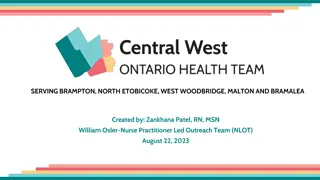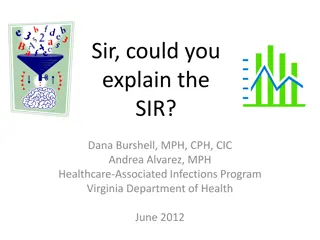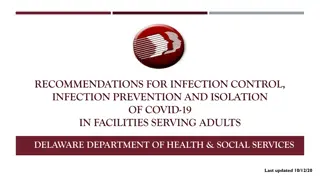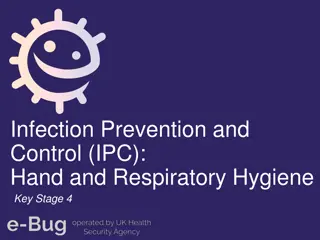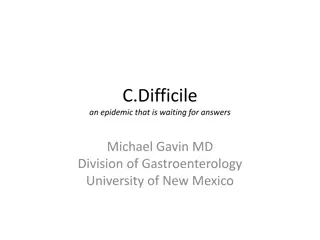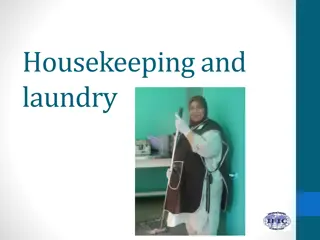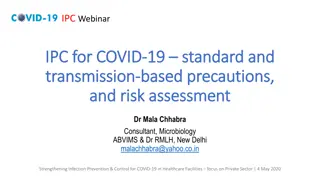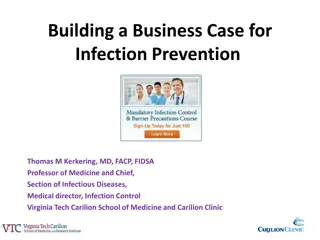Effective Strategies for Infection Prevention and Control in Schools
Implementing proper infection prevention and control measures is crucial in school settings, especially during the COVID-19 pandemic. This includes promoting hand hygiene, respiratory etiquette, staying home when ill, and ensuring good ventilation. Following these guidelines can help reduce the spread of infections and create a safer environment for students and staff.
Download Presentation

Please find below an Image/Link to download the presentation.
The content on the website is provided AS IS for your information and personal use only. It may not be sold, licensed, or shared on other websites without obtaining consent from the author.If you encounter any issues during the download, it is possible that the publisher has removed the file from their server.
You are allowed to download the files provided on this website for personal or commercial use, subject to the condition that they are used lawfully. All files are the property of their respective owners.
The content on the website is provided AS IS for your information and personal use only. It may not be sold, licensed, or shared on other websites without obtaining consent from the author.
E N D
Presentation Transcript
Infection, prevention and control Chapter 2: infection, prevention and control Chapter 2: infection prevention and control - GOV.UK (www.gov.uk) Schools COVID-19 operational guidance Schools COVID-19 operational guidance (publishing.service.gov.uk) Living safely with respiratory infections, including COVID-19 Living safely with respiratory infections, including COVID-19 - GOV.UK (www.gov.uk) 2
Hand hygiene Respiratory and cough hygiene Cleaning IPC Staying away when ill Ventilation 3
Hand hygiene Hand washing is one of the most important ways of controlling the spread of infections, especially those that cause diarrhoea and/or vomiting and respiratory infections. Hand washing As often as possible for at least 20 seconds: - Using soap and warm water - Alcohol gel otherwise (allow to dry) As often as possible for at least 20 seconds: Ideally soap and warm water Alcohol gel otherwise (allow to dry). Definitely - After coughing/sneezing - Before food preparation - After toileting Definitely: Before and after resident contact After coughing/sneezing Before food preparation After toileting. Correct technique is essential - Includes wrists and forearms Correct technique essential Include wrist and forearm. Link to online video COVID-19 and Domiciliary Care IPC training (2) April 2020: PHE London working with ADPH London Recommend that hand hygiene posters are displayed for staff and pupils, acting as a guide and a prompt 23 4
Staying away when ill Ensure that any children and young people who have a high temperature and are unwell do not attend the education or childcare setting until they no longer have a high temperature and are well enough to attend. Chapter 3: public health management of specific infectious diseases - GOV.UK (www.gov.uk) Exclusion table - GOV.UK (www.gov.uk) e-Bug | England Home 6
Ventilation Research shows that being in a room with fresh air can reduce your risk of infection from particles by over 70%, as fresh air dilutes the particles. Opening windows and doors Open windows for short, sharp bursts of 10 to 15 minutes regularly throughout the day Leave windows open a small amount continuously Ventilation of indoor spaces to stop the spread of coronavirus (COVID-19) - GOV.UK (www.gov.uk) New film shows importance of ventilation to reduce spread of COVID-19 - GOV.UK (www.gov.uk) 7
Cleaning Cleaning with detergent and water is normally all that is needed as it removes the majority of germs that can cause disease Clean regularly (especially high touch points, toilet flushes, hand rails, door handles) Cleaning equipment used should be disposable or, if reusable, disinfected after each use. Consideration should be given to situations where additional cleaning will be required including during term time (for example in the event of an outbreak) and how the setting might carry this out. A nominated member of staff should monitor cleaning standards and discuss any issues with cleaning staff, or contractors employed by the education or childcare setting. 8
Increase in cases? to consider (for all infectious diseases) Increasing cleaning classrooms, lunch halls, toilets flushes, taps, door handles, high touch points Risk assess open days, visits, performances, other group activities Social distancing reduce numbers in pinch points , online staff meetings, reducing numbers in assemblies and other spaces Face mask - not required, could be advised by the Local Authority Public Health Director PPE - Most staff in schools will not require PPE beyond what they would normally need for their work Isolation not legally required (but if have test positive recommended 3 days pupils, 5 days adults) Contract tracing not required Testing not required 9





